FSP Twins 500W Redundant PSU Review
The FSP Twins series combines the usability of a normal ATX PSU and the advanced features of a redundant server unit. The Twins 500W we're evaluating today addresses users that need an ultra-reliable PSU and are willing to pay for it.
Why you can trust Tom's Hardware
Load Regulation, Hold-Up Time, And Inrush Current
To learn more about our PSU tests and methodology, please check out How We Test Power Supply Units.
Primary Rails And 5VSB Load Regulation
Load Regulation testing is detailed here.
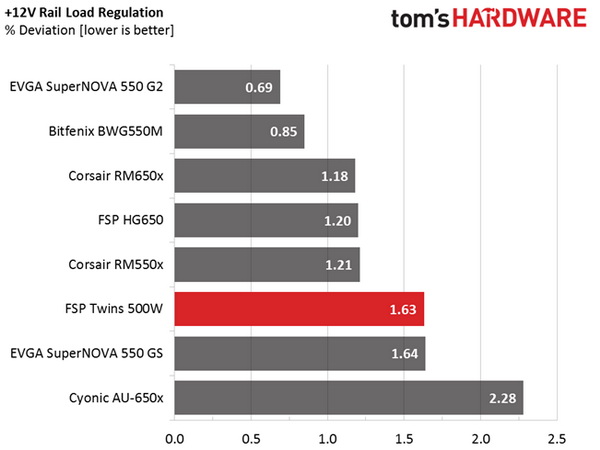

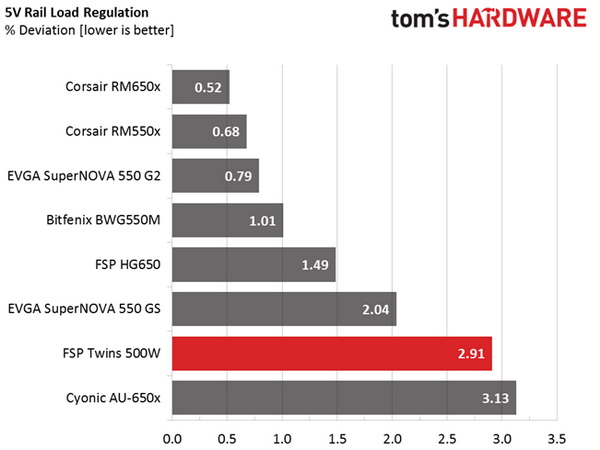


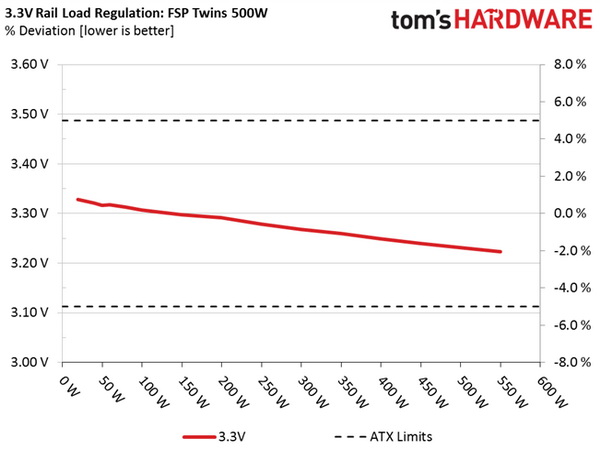


Hold-Up Time
Our hold-up time tests are described in detail here.

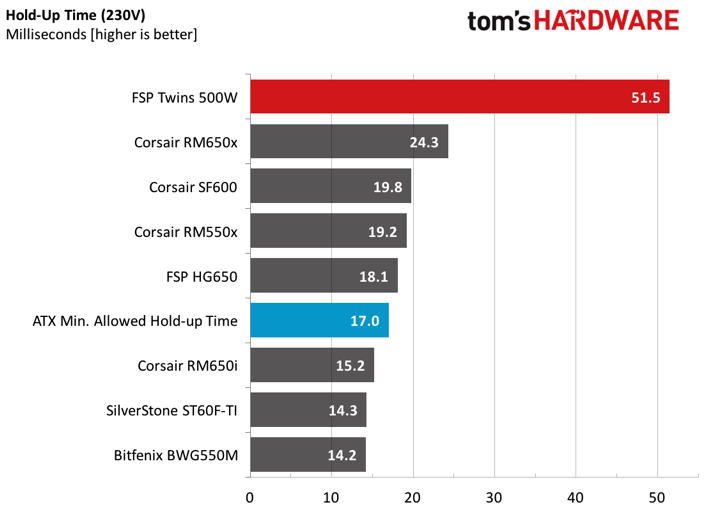



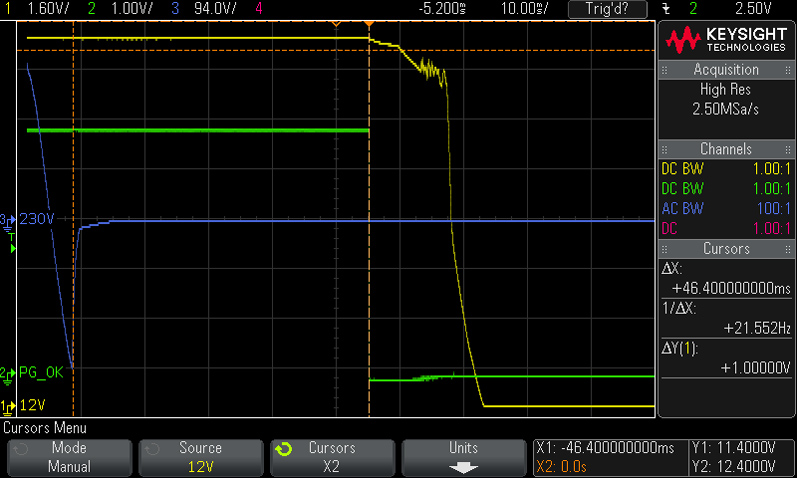
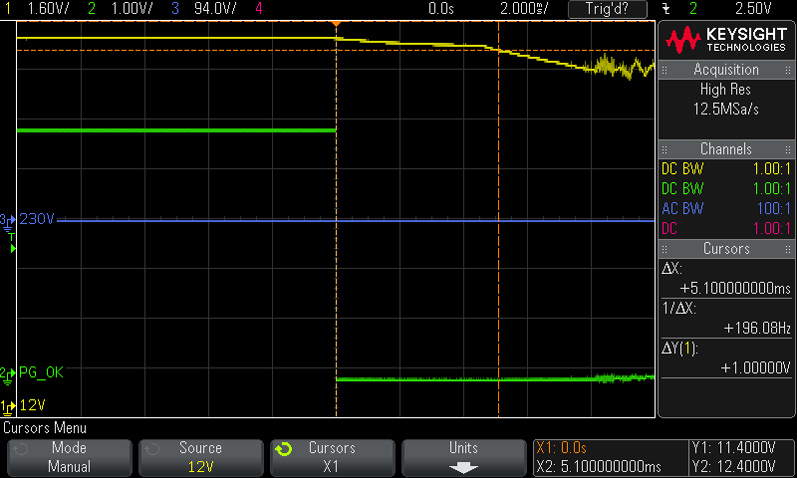
Our hold-up time result is very long since the bulk caps of both modules are utilized in this test. On top of that, we need to see a large number for a smooth transition to take place from one module to the other in case of a failure.
Inrush Current
For details on our inrush current testing, please click here.


The inrush current is quite low with 115V input, while it's on the high side with 230V (still, we see less than 50A).
Load Regulation And Efficiency Measurements
The first set of tests reveals the stability of the voltage rails and the Twins 500W's efficiency. The applied load equals (approximately) 10 to 110 percent of the PSU's maximum load in increments of 10 percentage points.
Get Tom's Hardware's best news and in-depth reviews, straight to your inbox.
We conducted two additional tests. During the first, we stressed the two minor rails (5V and 3.3V) with a high load, while the load at +12V was only 0.1A. This test reveals whether a PSU is Haswell-ready or not. In the second test, we determined the maximum load the +12V rail could handle with minimal load on the minor rails.
| Test # | 12V | 5V | 3.3V | 5VSB | DC/AC (Watts) | Efficiency | Fan Speed | Fan Noise | Temps (In/Out) | PF/AC Volts |
|---|---|---|---|---|---|---|---|---|---|---|
| 1 | 2.337A | 1.995A | 1.988A | 0.990A | 49.75 | 67.540% | 8233 RPM | 53.8 dB(A) | 37.05°C | 0.939 |
| 12.056V | 5.005V | 3.316V | 5.049V | 73.66 | 40.97°C | 115.1V | ||||
| 2 | 5.726A | 3.001A | 2.990A | 1.190A | 99.74 | 78.498% | 8782 RPM | 55.3 dB(A) | 38.99°C | 0.970 |
| 12.033V | 4.986V | 3.307V | 5.032V | 127.06 | 43.43°C | 115.1V | ||||
| 3 | 9.471A | 3.515A | 3.514A | 1.395A | 149.84 | 82.945% | 8844 RPM | 55.6 dB(A) | 39.16°C | 0.978 |
| 12.013V | 4.973V | 3.298V | 5.013V | 180.65 | 43.82°C | 115.1V | ||||
| 4 | 13.224A | 4.034A | 4.009A | 1.600A | 199.79 | 85.260% | 9124 RPM | 55.2 dB(A) | 39.44°C | 0.986 |
| 11.992V | 4.962V | 3.291V | 4.995V | 234.33 | 44.60°C | 115.1V | ||||
| 5 | 16.646A | 5.052A | 5.029A | 1.805A | 249.74 | 86.466% | 9294 RPM | 54.9 dB(A) | 39.89°C | 0.989 |
| 11.972V | 4.945V | 3.279V | 4.977V | 288.83 | 45.52°C | 115.1V | ||||
| 6 | 20.082A | 6.090A | 6.055A | 2.015A | 299.71 | 87.120% | 9609 RPM | 54.7 dB(A) | 40.52°C | 0.991 |
| 11.947V | 4.928V | 3.268V | 4.958V | 344.02 | 46.43°C | 115.1V | ||||
| 7 | 23.524A | 7.126A | 7.084A | 2.225A | 349.72 | 87.371% | 9836 RPM | 52.2 dB(A) | 41.14°C | 0.993 |
| 11.930V | 4.912V | 3.259V | 4.940V | 400.27 | 47.53°C | 115.1V | ||||
| 8 | 26.992A | 8.180A | 8.127A | 2.436A | 399.76 | 87.408% | 10316 RPM | 50.4 dB(A) | 41.98°C | 0.994 |
| 11.905V | 4.894V | 3.249V | 4.920V | 457.35 | 48.73°C | 115.1V | ||||
| 9 | 30.915A | 8.711A | 8.673A | 2.440A | 449.73 | 87.406% | 10718 RPM | 51.6 dB(A) | 42.88°C | 0.995 |
| 11.875V | 4.882V | 3.240V | 4.911V | 514.53 | 50.12°C | 115.1V | ||||
| 10 | 34.551A | 9.248A | 9.192A | 3.075A | 499.67 | 87.196% | 11062 RPM | 52.5 dB(A) | 43.90°C | 0.996 |
| 11.865V | 4.869V | 3.231V | 4.877V | 573.04 | 51.63°C | 115.1V | ||||
| 11 | 38.834A | 9.258A | 9.211A | 3.078A | 549.61 | 87.074% | 11556 RPM | 54.8 dB(A) | 44.62°C | 0.997 |
| 11.843V | 4.863V | 3.223V | 4.870V | 631.20 | 52.90°C | 115.1V | ||||
| CL1 | 0.099A | 16.026A | 16.004A | 0.004A | 131.32 | 75.947% | 14706 RPM | 53.5 dB(A) | 43.43°C | 0.976 |
| 12.011V | 4.863V | 3.260V | 5.091V | 172.91 | 47.57°C | 115.1V | ||||
| CL2 | 41.624A | 1.004A | 1.003A | 1.002A | 507.25 | 88.205% | 11013 RPM | 52.5 dB(A) | 44.03°C | 0.996 |
| 11.868V | 4.955V | 3.264V | 4.997V | 575.08 | 51.42°C | 115.1V |
Load regulation at +12V is satisfactory, but it's quite loose on the minor rails. Apparently, the frame's DC-DC converters need some modification in order to offer tighter voltage outputs.
Efficiency under light loads is pretty low because the output of two PSUs is combined, doubling their power losses. Moreover, under high ambient temperatures, both fans are quite loud. We also notice a fan bearing noise in the 8000-10,000 RPM range. For those of you who weren't expecting such high acoustic readings, remember that this is a server-class PSU running under tough conditions. In addition to costing more money, professional power supplies delivering increased reliability and redundant functionality also tend to be loud. If you don't want a noisy PC, stay away from this FSP offering.
FSP Guardian Screenshots
You will find several screenshots of the FSP Guardian software below.













Current page: Load Regulation, Hold-Up Time, And Inrush Current
Prev Page FSP Guardian Software Next Page Efficiency, Temperature, And Noise
Aris Mpitziopoulos is a contributing editor at Tom's Hardware, covering PSUs.
-
shrapnel_indie ReplyPros
Full power at 45°CAll cables are fixed, and because this is a server-like product, its maximum operating temperature for continuous full power delivery is 50°C.
Please explain to me why these numbers don't seem to match up properly. (THB, I may have missed it.)
-
dstarr3 I really wonder what a consumer could possibly want this for. What is an ordinary consumer doing that they absolutely cannot risk any downtime whatsoever on their rig?Reply -
nzalog I know freenas can be configured to work faster if you can for sure trust the system from not having RAM errors (covered by ECC) and if you can guarantee there is no unexpected shutdown (covered by dual power and ups). However the reliable power is not really required because a SSD as an SLOG device will cover for it, but then the SSD becomes the bottleneck for writes.Reply -
firefoxx04 I build several file servers a month for clients. Low end enough to where pre built solutions are not an option. This power supply would be a good fit but it is useless, imo, without some sort of email alert option. Maybe I missed that?Reply
When I deploy file servers for clients, I always setup some sort of alert system for raid failures so I can fix the problem. What is the point of redundancy if the user has no idea a problem has occurred? Yes i know that this PSU makes a "loud buzzer noise" but I cant have that either. The user needs to continue to use the system and they cannot if it is screaming 100% of the time.
Send me an email alert. Its easy to implement. -
Rookie_MIB One thing I'm curious about - what if one unit does fail? Are they bog-standard replacement parts where you can go and buy a similar hot swap redundant power supply or is the system proprietary. If it's the latter, then I don't see many people lining up for this one...Reply -
apache_lives A PSU is but one part of a "reliable" machine, to me this will not increase up time or do anything of any value, seems more like a "makes me feel better" part.Reply -
Aris_Mp about the first comment, the PSU is certified for up to 50C ambient full power delivery, but I choose to test up to 45C every PSU that passed from my test bench (since I also have to evaluate 40C rated units and I need to keep the same conditions for all).Reply -
shrapnel_indie Reply19144735 said:about the first comment, the PSU is certified for up to 50C ambient full power delivery, but I choose to test up to 45C every PSU that passed from my test bench (since I also have to evaluate 40C rated units and I need to keep the same conditions for all).
While I'm glad for that, It's also nice to know if a unit rated at 50°C operation will deliver on its "promise" though. (If you exceed the "promised" rating, like the 40°C rated units @ 45, well, it delivered on its promise and then some.)
-
Pompompaihn Newegg has several server chassis for sale that come WITH redundant 500w+ PSUs for less money than just this power supply. Given that the market is low end commercial/prosumer, and it's not going to be for gaming or HTPC, why wouldn't you just buy the whole thing for cheaper?Reply


